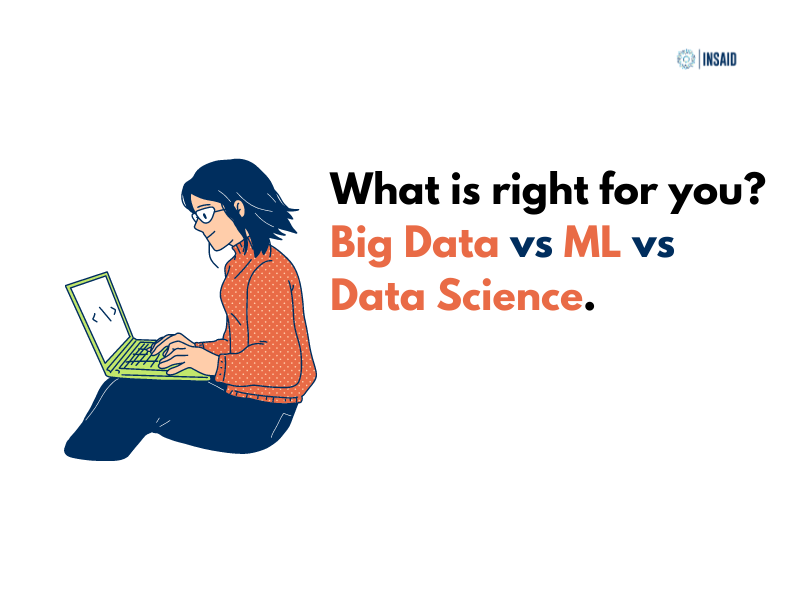One question that data professionals have to put up with time and again is what is the difference between data science, machine learning and big data? You know, they think ‘Are they overlapping fields or are they poles apart?’
Let’s break it down together in this blog and understand what is what.
Anyone who’s deeply involved in the world of technology or wants to live in the future has surely heard the term big data, data science and machine learning.
Today the world is sitting over a Data Goldmine! IBM claims that everyday we create about 2.5 quintillion bytes of data, a quintillion, you know what a quintillion is?
A quintillion is a billion X billion!
However, we’re going to talk about the difference between big data, machine learning and finally, data science.
So starting with big data. Now, big data is not your conventional data. Big Data encompasses all kinds of data that is structured, semi structured, unstructured and is based on three fundamental pillars or the three V’s which we know as:
- Volume: Organizations collect data from a variety of sources, including transactions, smart (IoT) devices, industrial equipment, videos, images, audio, social media and more. In the past, storing all that data would have been too costly – but cheaper storage using data lakes, Hadoop and the cloud have eased the burden.
- Velocity: With the growth in IOT, data streams into businesses at an unprecedented speed and must be handled in a timely manner. RFID tags, sensors and smart meters are driving the need to deal with these torrents of data in near-real time.
- Variety: Data comes in all types of formats – from structured, numeric data in traditional databases to unstructured text documents, emails, videos, audios, stock ticker data and financial transactions.
When you combine big data with high-performance analytics, you can accomplish business-related tasks such as:
- Determining root causes of failures, issues and defects in near-real time
- Spotting anomalies faster and more accurately than the human eye
- Improving patient outcomes by rapidly converting medical image data into insights
- Recalculating entire risk portfolios in minutes
- Sharpening deep learning models’ ability to accurately classify and react to changing variables
- Detecting fraudulent behavior before it affects your organization
Coming to Machine learning. Machine learning is a discipline under Data Science, it imparts and empowers machines to think and act for themselves.
Here are a few widely publicized examples of machine learning applications you may be familiar with:
- The heavily hyped, self-driving Google car (WAYMO)? The essence of machine learning
- Online recommendation offers such as those from Amazon and Netflix? Machine learning applications for everyday life
- Knowing what customers are saying about you on Twitter? Machine learning combined with linguistic rule creation
- Fraud detection? One of the more obvious, important uses in our world today
So in other words, ML technology enables computers that can learn from patterns and behavior and act accordingly, without any human intervention, or without being explicitly programmed to do so.
Finally, we come to the very very root of it all, which is called data science. Now, data science is a discipline that utilizes a combination of mathematical, statistical and computational tools to acquire processes and then analyze big data.
Click here to read more on what Data Science is
Thus, big data and ML fits right into the broader canvas of data science, that takes into consideration the entire concept of processing data of a large site. Now that we have managed to simplify it a little bit for you. Let us tell you how to pick between these fields.
So if you’re someone who is equipped with exceptional programming skills and you’re well versed in big data infrastructure, you should offer a career in big data. Because big data encompasses roles like big data engineer or big data architect.
Now, if data structures, algorithms and mathematical models interest you, ML is the perfect career for you. Companies are constantly on the hunt for talented machine learning engineers who can work with algorithms to transfer data into actionable insights for an enhanced customer experience.
Do check out the video below as well, for a quick recap of the concepts discussed in the blog.
If you are aiming for something more ambitious, like playing with vast amounts of data and getting valuable insights from them, then you have to go for data science, as it is all about extracting meaningful insights and patterns from large data sets, and then visualizing them into data driven business decisions.
Hopefully this gives you some clarity on what each of these fields entails and how you can go about picking the right field for you to make a successful career.
 Pin
PinWe hope you like these three ways of transitioning to a data science career. If you’d like to read more like this, check out our blog page to find out more!






